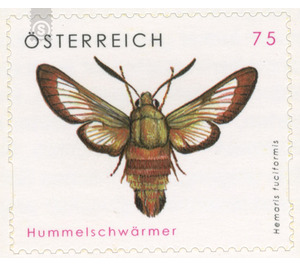animal welfare - Austria / II. Republic of Austria 2008 - 75 Euro Cent
Theme: Animals
| Country | Austria / II. Republic of Austria |
| Issue Date | 2008 |
| Face Value | 75.00 |
| Edition Issued | 350,000 |
| Printing Type | Photogravure |
| Stamp Type | Commemorative |
| Item Type | Stamp |
| Chronological Issue Number | 2091 |
| Chronological Chapter | OOS-OE2 |
| SID | 27249 |
| In 47 Wishlists | |
The bumblebee (Hemaris fuciformis) is a diurnal butterfly found in much of Europe. The moth reaches a wingspan of about 38 to 48 millimeters and he has, therefore his name, much resemblance to bumblebees. The two wing pairs are mostly transparent. The outer edge of the forewings is colored especially reddish to the wing tip, the hind wings also have such a hem. The evolutionary cycle of these species varies greatly, which is why in smaller observation areas the number of generations occurring per year varies between one and two. The intriguing thing about butterflies is undoubtedly their wonderful metamorphosis from the caterpillar to the fragile body of a moth. The females of the bumblebees lay their globular, pale green shimmering eggs individually on the underside of the leaves of the caterpillar feed plants. Here, plants are shunned in blazing sun or in full-day shady location. The mainly nocturnal caterpillars rest during the day. The pupation finally takes place in a loosely spun cocoon, are planted in the plant parts. Like many other butterfly species, the bumblebee is listed in the so-called "Red List of Endangered Species". The paradisiac beauty of many species of butterflies, their fragile delicate body and the elegance of their wings make these animals - in general - real "sympathy" and too often used symbols in poetry. A colloquial example is, for example, the feeling of "butterflies in the stomach" as the feeling of being young in love felt happy by everyone. Characteristic of the appearance of the hoopoe (Upupa epops) are the black and white banded wings with clear visible yellow inclusions, the long, curved beak and the approximately five to six centimeters long feather cap, whose ends terminate in a white-black finish. The hoopoe populates different habitats, but there are always heat-exposed, dry and loosely wooded areas with only sparse vegetation. In Central Europe, the species occurs mainly in fruit and wine crops and in areas with grazing livestock. Also pine forests and extensive islands of clearing in closed tree stands serve occasionally as breeding area. In the Mediterranean, the species can sometimes be observed in olive crops and in cork oak stands. The hoopoe feeds mainly on insects. Preference is given to larger species such as crickets, grubs, beetles and various types of caterpillars. Less common are spiders, woodlice, millipedes, earthworms - but also small frogs and lizards! - "consumed". In Europe, the hoopoe was a common breeding bird in some areas until the fifties of the 20th century. Various factors - primarily the Atlantic climate, biotope destruction and increased pesticides - triggered a sharp decline in stocks. Even in the Hoopoe can make a remark to the keyword "metamorphosis" - albeit in quite a different, namely literary context: In the "metamorphoses" of Ovid, the Thraki king Tereus transformed into a hoopoe. This narrative is considered particularly cruel; It also refers to the shape of the beak, which resembles a sword.


